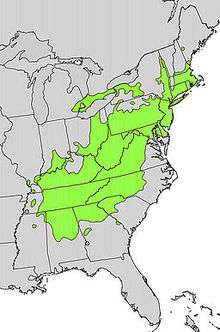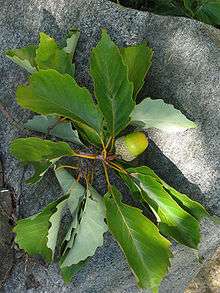Quercus prinus
| Quercus prinus | |
|---|---|
| | |
| Chestnut Oak in Weiser State Forest | |
| Scientific classification | |
| Kingdom: | Plantae |
| (unranked): | Angiosperms |
| (unranked): | Eudicots |
| (unranked): | Rosids |
| Order: | Fagales |
| Family: | Fagaceae |
| Genus: | Quercus |
| Section: | Quercus |
| Species: | Q. prinus |
| Binomial name | |
| Quercus prinus L. | |
 | |
| Natural range | |
Quercus prinus (syn. Quercus montana), the chestnut oak, is a species of oak in the white oak group, Quercus sect. Quercus. It is native to the eastern United States, where it is one of the most important ridgetop trees from southern Maine southwest to central Mississippi, with an outlying northwestern population in southern Michigan. It is also sometimes called "rock oak" because of montane and other rocky habitats. As a consequence of its dry habitat and ridgetop exposure, it is not usually a large tree, typically 18–22 m (59–72 ft) tall; occasional specimens growing in better conditions can however become large, with trees up to 40–43 m (131–141 ft) tall known. They tend to have a similar spread of 18–22 m (59–72 ft). A 10-year-old sapling will stand about 5 m (16 ft) tall. This species is often an important canopy species in an oak-heath forest.[1][2]
Taxonomy and nomenclature
Extensive confusion between the chestnut oak (Quercus prinus) and the swamp chestnut oak (Quercus michauxii) has occurred, and some botanists have considered them to be the same species in the past.
The name Quercus prinus was long used by many botanists and foresters for either the chestnut oak or the swamp chestnut oak, with the former otherwise called Q. montana or the latter otherwise called Q. michauxii. The application of the name Q. prinus to the chestnut oak is now often accepted,[3][4] although sometimes that name is declared to be of uncertain position, unassignable to either species, with the chestnut oak then called Q. montana, as in the Flora of North America.[5]
Description


The chestnut oak is readily identified by its massively-ridged dark gray-brown bark, the thickest of any eastern North American oak. The leaves are 12–20 cm long and 6–10 cm broad, shallowly lobed with 10–15 rounded lobes on each margin; they are virtually identical to the leaves of swamp chestnut oak and chinkapin oak, but the trees can readily be distinguished by the bark, that of the chinkapin oak being a light ash-gray and somewhat peeling like that of the white oak and that of swamp chestnut oak being paler ash-gray and scaly. The chinkapin oak also has much smaller acorns than the chestnut oak. The chestnut oak is easily distinguished from the swamp white oak because that tree has whitened undersides on the leaves. Another important distinction between the chestnut oak and the swamp chestnut oak is by the habitat; if it grows on a ridge, it is chestnut oak, and if it grows in wet bottomlands, it is probably the more massive swamp chestnut oak; however, this is not fully reliable.
Characteristics of the chestnut oak include:[6]
- Bark: Dark, fissured into broad ridges, scaly. Branchlets stout, at first bronze green, later they become reddish brown, finally dark gray or brown. Heavily charged with tannic acid.
- Wood: Dark brown, sapwood lighter; heavy, hard, strong, tough, close-grained, durable in contact with the soil. Used for fencing, fuel, and railway ties. Sp. gr., 0.7499; weight of cu. ft., 46.73 lbs.
- Winter buds: Light chestnut brown, ovate, acute, one-fourth to one-half of an inch long.
- Leaves: Alternate, five to nine inches long, three to four and a half wide, obovate to oblong-lanceolate, wedge-shaped or rounded at base, coarsely crenately toothed, teeth rounded or acute, apex rounded or acute. They come out of the bud convolute, yellow green or bronze, shining above, very pubescent below. When full grown are thick, firm, dark yellow green, somewhat shining above, pale green and pubescent below; midribs stout, yellow, primary veins conspicuous. In autumn they turn a dull yellow soon changing to a yellow brown. Petioles stout or slender, short. Stipules linear to lanceolate, caducous.
- Flowers: May, when leaves are one-third grown. Staminate flowers are borne in hairy aments two to three inches long; calyx pale yellow, hairy, deeply seven to nine-lobed; stamens seven to nine; anthers bright yellow. Pistillate flowers on short spikes; peduncles green, stout, hairy; involucral scales hairy; stigmas short, bright red.
- Acorns: Annual, singly or in pairs; nut oval, rounded or acute at apex, bright chestnut brown, shining, one and a quarter to one and one-half inches in length; cup, cup-shaped or turbinate, usually inclosing one-half or one-third of the nut, thin, light brown and downy within, reddish brown and rough outside, tuberculate near the base. Scales small, much crowded toward the rim sometimes making a fringe. Kernel white, sweetish.
The acorns of the chestnut oak are 1.5–3 cm long and 1–2 cm broad, among the largest of native American oaks, surpassed in size only by the bur oak and possibly swamp chestnut oak,
Ecology

This species is a predominant ridge-top tree in eastern North American hardwood forests. It often grows with multiple trunks, often as a result of prior injury to the main stem. It is a long-lived tree, with high-quality timber when well-formed. The acorns of the chestnut oak are a valuable wildlife food.
Uses
Chestnut oak trees are generally not the best timber trees because they are usually branched low and not very straight, but when they grow in better conditions, they are valuable for timber, which is marketed as 'mixed white oak'.
Notes
- ↑ The Natural Communities of Virginia Classification of Ecological Community Groups (Version 2.3), Virginia Department of Conservation and Recreation, 2010
- ↑ Schafale, M. P. and A. S. Weakley. 1990. Classification of the natural communities of North Carolina: third approximation. North Carolina Natural Heritage Program, North Carolina Division of Parks and Recreation.
- ↑ ITIS (the Integrated Taxonomic Information System) accepts Q. prinus as the accepted name for the chestnut oak.
- ↑ The confusion arose from differing identifications of the type specimens for the Linnaean name, by some (but not all) botanists considered resolved by close examination of the leaf pubescence, which differs in the two species.
- ↑ "Quercus montana". Flora of North America. Retrieved 8 October 2011.
- ↑ Keeler, Harriet L. (1900). Our Native Trees and How to Identify Them. New York: Charles Scriber's Sons. pp. 338–344.
Additional references
- Flora of North America: Quercus montana RangeMap
- ITIS Taxonomic Report: Quercus prinus L.
- ITIS Taxonomic Report: Quercus montana (synonum of Quercus prinus L.)
- USDA Plants Profile: Quercus prinus L.
| Wikimedia Commons has media related to Quercus montana (syn: Quercus prinus). |
